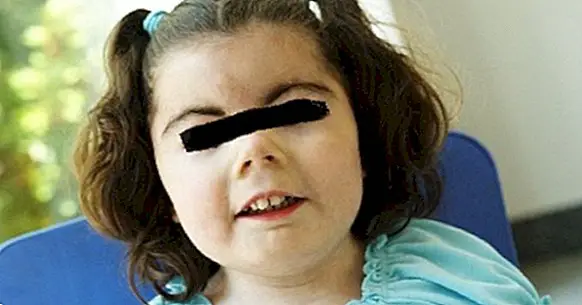Cornelia de Lange syndrome: causes, symptoms and treatment
Genetic mutations are responsible for generating an immense amount of changes or variations between people. However, when these alterations occur in a series of determined genes they can lead to the appearance of diseases or congenital syndromes.
One of these conditions is the Cornelia de Lange syndrome , which is expressed through a series of physical and mental characteristics. In this article its manifestations, causes and diagnosis will be described.
- Related article: "The differences between syndrome, disorder and disease"
What is Cornelia de Lange syndrome?
The Cornelia de Lange syndrome (SCdL) is a congenital multiple malformation disease that is characterized by being hereditary in a dominant way and for causing an alteration in the development of the child.
This syndrome manifests through a very characteristic facial phenotype , a delay in growth both prenatally and postnatally and by a disorder of intellectual development or cognitive deficits that may occur to a variable degree.
Also, in many occasions people suffering from Cornelia de Lange Syndrome also suffer some type of abnormality or malformation in their upper extremities.
Three types of phenotypes can be distinguished according to the intensity of the symptoms: the severe phenotype, the moderate phenotype and the mild phenotype.
According to the different investigations, the prevalence of this syndrome is an affected person in between 45,000 and 62,000 births . However, most cases of Cornelia de Lange occur in families with dominant inheritance patterns.
Finally, estimating life expectancy is a very complicated task since it can vary from one person to another depending on the severity of the syndrome and the associated pathologies.
Traditionally, The main cause of death was related to a poor diagnosis of the disease and of the associated pathologies. However, thanks to medical advances, both in diagnosis and in treatments, they have managed to change this.
Clinical features
Within the distinctive physical features of this disease we find a weight below normal at birth, being below 2.2 kg . approximately. As well as a development of slow growth, a short stature and presence of microcephaly.
As far as the facial phenotype is concerned, this usually presents united eyebrows and with pronounced angles, small nose, large eyelashes and thin lips in an inverted "V" shape.
Other common signs of Cornelia de Lange syndrome are:
- Hirsutism .
- Small hands and feet
- Partial fusion of the second and third toe.
- Curved little fingers.
- Esophageal reflux .
- Convulsions
- Cardiac abnormalities
- Cleft palate .
- Intestinal abnormalities.
- Hearing loss and sight.
With regard to behavioral symptoms, children with Cornelia de Lange usually present self-injurious behaviors such as nibbling on their fingers, lips and upper extremities.
Causes
The causes of the Cornelia de Lange syndrome are purely genetic. Within these genetic causes there are two types of mutations that can cause this condition.
The main genetic alteration that has Cornelia de Lange as a consequence is a mutation in the NIPBL gene . However, there are other cases of this syndrome caused by mutations in the SMC1A and SMC3 genes and, to a lesser extent, the mutations found in the HDAC8 and RAD21 genes.
The NIPBL gene has a primordial role in human development It is already responsible for coding the protein front. This protein is one of those responsible for controlling the activity of chromosomes during the division of cells.
Likewise, the protein front mediates in the tasks of other genes in charge of the fetus to develop normally, specifically those genes responsible for the development of the tissues that will later form the extremities and the face.
- You may be interested: "Seckel syndrome: causes, symptoms and treatment"
Diagnosis
There is not yet an established protocol for the diagnosis of Cornelia de Lange syndrome, and it is necessary to resort to clinical data. However, the clarity and visibility of the symptoms make it relatively easy to diagnose .
Through the study of characteristic facial features, the evaluation of intellectual performance and the measurement of pondoestatural growth can be carried out an effective diagnosis of this syndrome.
Although this diagnosis is relatively simple, there are a number of difficulties when dealing with conditions with a mild phenotype. The phenotypes that involve difficulties at the time of diagnosis are:
Mild phenotype
They are not usually diagnosed until after the neonatal period. In these cases abnormalities are not shown in the extremities and both the general phenotype and intelligence are not very altered.
Moderate or variable phenotype
In these cases, the great variability in both features and expressions makes diagnosis difficult.
Through the study of characteristic facial features, the evaluation of intellectual performance and the measurement of pondoestatural growth can be carried out an effective diagnosis of this syndrome.
Due to these difficulties, the diagnosis during the prenatal period is only plausible in siblings of people affected by the disease, when there is some type of anomaly in the family members, in cases of hydrocephalus or in intrauterine development delays evident in the ultrasound
What options or needs do people with SDdL have?
As mentioned above, the degree of intellectual development of people with Cornelia de Lange can vary from one to another, each of them will have the ability to prosper according to their personal possibilities and to the aids and supports that provide their family and social environment .
Unfortunately, both language and communication in general tend to be severely affected. Even in the mildest cases, the evolution of these aspects can be seriously compromised.
Due to the needs of children with Cornelia de Lange it is advisable to provide them with a calm and relaxed environment, eliminating any element that may be disturbing, distressing or threatening to the child. In this way it will be avoided to reinforce the tendencies to the hyperactivity, the irritability and the self-aggressive behaviors .
The main objective when interacting or living with children with Cornelia de Lange syndrome is to perceive and feel through the child's conditions, without forcing them to perceive things as we perceive them.



















